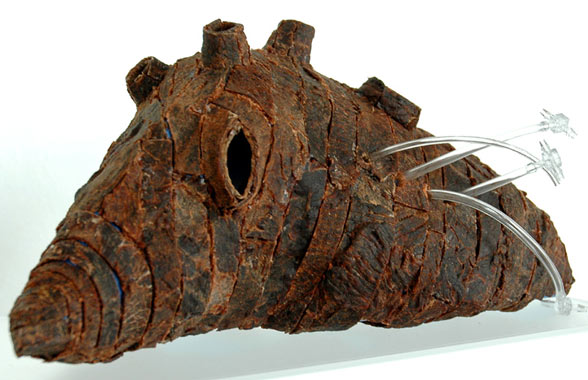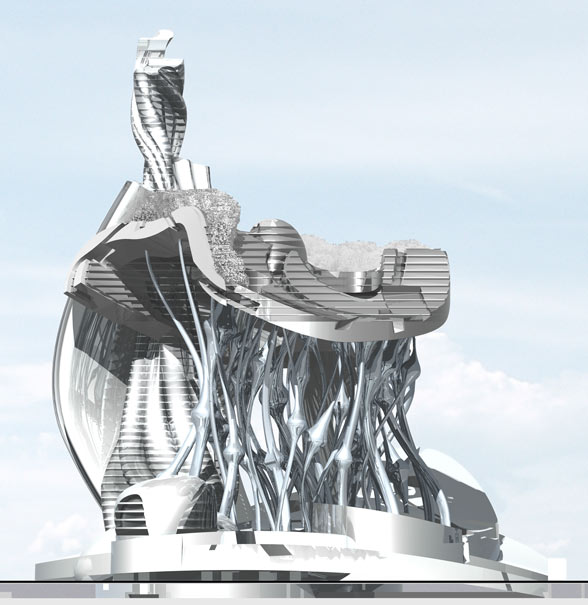Imagining and Realizing Our Future Cities

Who will you meet?
Cities are innovating, companies are pivoting, and start-ups are growing. Like you, every urban practitioner has a remarkable story of insight and challenge from the past year.
Meet these peers and discuss the future of cities in the new Meeting of the Minds Executive Cohort Program. Replace boring virtual summits with facilitated, online, small-group discussions where you can make real connections with extraordinary, like-minded people.
On a cold Sunday afternoon last winter my eleven year old daughter, Tyla, was sick and we visited the local walk-in clinic to see a doctor. Knowing there would be a lengthy wait time, I brought my digital device to research sustainable design (and, hopefully, not end up watching the Mindcraft videos my daughter would surely request). As many OCAD University students and faculty are interested in sustainability, I knew the topic would make for a good exhibition and I wanted to learn more about the current conversation.
The site that held our attention the most was from design group Terreform ONE, a non-profit New York-based design group that promotes environmentally conscious urban planning. Scientists, artists, architects and students collaboratively explore and advance the larger framework of socio-ecological design through their projects. Their designs are an exciting mixture of architecture, landscape, urban design, biology, engineering and art and are dedicated to finding innovative solutions for sustainability in energy, transportation, city infrastructure and waste management.
My daughter and I spent over four hours looking through their projects, some completed and currently in use, some futuristic and abstract. Tyla had no problem imagining a city with cars that look like lambs or living tree houses—in fact, she talked about the possibilities for hours afterwards!
I want to share with you a few of the projects Tyla and I discovered that day:
Reusing Refuse
Currently, every hour the City of New York produces enough waste to fill the Statue of Liberty. Toronto produces over 57 tons per hour. Terreform ONE has designed a unique way to reuse this waste:
[blockquote cite=”Rapid Re(f)use: Waste to Resource” citeLink=”http://www.terreform.org/projects_urbanity_rapid_refuse.html”]New York City is disposing of 38,000 tons of waste per day. Most of this discarded material ended up in Fresh Kills landfill before it closed. The Rapid Re(f)use project supposes an extended New York reconstituted from its own landfill material. Our concept remakes the city by utilizing the trash at Fresh Kills. With our method, we can remake seven entirely new Manhattan islands at full scale. Automated robot 3d printers are modified to process trash and complete this task within decades. These robots are based on existing techniques commonly found in industrial waste compaction devices. Instead of machines that crush objects into cubes, these devices have jaws that make simple shape grammars for assembly. Different materials serve specified purposes; plastic for fenestration, organic compounds for temporary scaffolds, metals for primary structures, and etc. Eventually, the future city makes no distinction between waste and supply.[/blockquote]
Growing Houses to Think, Feel and Breath
Terreform ONE, has envisioned two types of building materials for homes, both radically different in the way they use materials as well as the way they return these materials to the earth when not in use. Imagine a home, grown from trees, native to their environment.
 [blockquote cite=”FAB TREE HAB: Living Graft Prefab Structure” citeLink=”http://www.terreform.org/projects_habitat_fab.html”]Our dwelling is composed with 100% living nutrients. Here traditional anthropocentric doctrines are overturned and human life is subsumed within the terrestrial environs. Home, in this sense, becomes indistinct and fits itself symbiotically into the surrounding ecosystem. This home concept is intended to replace the outdated design solutions at Habitat for Humanity. We propose a method to grow homes from native trees. A living structure is grafted into shape with prefabricated Computer Numeric Controlled (CNC) reusable scaffolds. Therefore, we enable dwellings to be fully integrated into an ecological community.[/blockquote]
[blockquote cite=”FAB TREE HAB: Living Graft Prefab Structure” citeLink=”http://www.terreform.org/projects_habitat_fab.html”]Our dwelling is composed with 100% living nutrients. Here traditional anthropocentric doctrines are overturned and human life is subsumed within the terrestrial environs. Home, in this sense, becomes indistinct and fits itself symbiotically into the surrounding ecosystem. This home concept is intended to replace the outdated design solutions at Habitat for Humanity. We propose a method to grow homes from native trees. A living structure is grafted into shape with prefabricated Computer Numeric Controlled (CNC) reusable scaffolds. Therefore, we enable dwellings to be fully integrated into an ecological community.[/blockquote]
They have also conceived a model for a structure grown from pig cells with windows that open and close with sphincter muscles.

[margin10]
[blockquote cite=”IN VITRO MEAT HABITAT” citeLink=”http://www.terreform.org/projects_habitat_meat.html”]This is an architectural proposal for the fabrication of 3D printed extruded pig cells to form real organic dwellings. It is intended to be a “victimless shelter”, because no sentient being was harmed in the laboratory growth of the skin. We used sodium benzoate as a preservative to kill yeasts, bacteria and fungi. Other materials in the model matrix are; collagen powder, xanthan gum, mannitol, cochineal, sodium pyrophosphate, and recycled PET plastic scaffold. As of now, the concept model consists of essentially very expensive fitted cured pork or articulated swine leather with an extensive shelf life. The actual scale of the non-perishable prototype is 11”x3”x7”. [/blockquote]
Meetings in a Moving Pod
Tired of waiting for the office elevator to take you to your meeting? Suppose you could start your client meeting on the ground floor and program a meeting pod to move slowly as you did your business. After an hour long meeting you and your clients arrive at a display area or a restaurant with no time or energy wasted.

[margin10]
[blockquote cite=”PERISTALTIC CITY: Circulatory Habitat Cluster for New York” citeLink=”http://www.terreform.org/projects_urbanity_peristaltic.html”]Peristal City is a tall building made of a cluster of shifting pod spaces. The pod skins alter the volume locations within. This soft, pliable, sealed, and non-mechanical innovation encapsulates volumetric structures. Textile reinforced hoses execute a peristaltic action. Thus, the modules are enabled to create an articulated motion that is symbiotically connected to an urban armature. By employing a dynamic spatial application against the traditional organization of core and space, we dissolved the dichotomy between circulation and habitable environments. We have eliminated typological stacking where experiences are vapidly suggested to be diversified by simply designating floors to particular social practices. Instead, we propose a spatial layout that establishes heterogeneous movements, and not just assorted practices, as the criteria for a dynamic assemblage.[/blockquote]
Since I began researching Terreform ONE, my imagination has been on fire. Collaboration between disciplines is key. And, it is crucial to radically alter what we think is possible in our environments, particularly as our cities become more dense. I am thrilled to be bringing Terreform ONE for a solo exhibition of projects to Onsite [at] OCAD University this fall, details below!
[colored_box bgColor=”#BFCBD5″ textColor=”#333333″]
Terreform ONE: An Opera of Disciplines from Architecture, Landscape, Urban Design, Biology, Engineering and Art
November 6, 2013 to February 22, 2014
Celebrate the exhibition opening on Wednesday. November 6th:
- 6:30-8pm: Lecture with Nurhan Gokturk, Mitchell Joachim and Richard M. Sommer, Rm 190 (100 McCaul)
- 8-10pm: Opening Reception at Onsite [at] OCAD U (230 Richmond West)
Onsite [at] OCAD U
230 Richmond Street West (street level)
416-977-6000 ext. 2208
More info[/colored_box]
Discussion
Leave your comment below, or reply to others.
Please note that this comment section is for thoughtful, on-topic discussions. Admin approval is required for all comments. Your comment may be edited if it contains grammatical errors. Low effort, self-promotional, or impolite comments will be deleted.
Read more from MeetingoftheMinds.org
Spotlighting innovations in urban sustainability and connected technology
Middle-Mile Networks: The Middleman of Internet Connectivity
The development of public, open-access middle mile infrastructure can expand internet networks closer to unserved and underserved communities while offering equal opportunity for ISPs to link cost effectively to last mile infrastructure. This strategy would connect more Americans to high-speed internet while also driving down prices by increasing competition among local ISPs.
In addition to potentially helping narrow the digital divide, middle mile infrastructure would also provide backup options for networks if one connection pathway fails, and it would help support regional economic development by connecting businesses.
Wildfire Risk Reduction: Connecting the Dots
One of the most visceral manifestations of the combined problems of urbanization and climate change are the enormous wildfires that engulf areas of the American West. Fire behavior itself is now changing. Over 120 years of well-intentioned fire suppression have created huge reserves of fuel which, when combined with warmer temperatures and drought-dried landscapes, create unstoppable fires that spread with extreme speed, jump fire-breaks, level entire towns, take lives and destroy hundreds of thousands of acres, even in landscapes that are conditioned to employ fire as part of their reproductive cycle.
ARISE-US recently held a very successful symposium, “Wildfire Risk Reduction – Connecting the Dots” for wildfire stakeholders – insurers, US Forest Service, engineers, fire awareness NGOs and others – to discuss the issues and their possible solutions. This article sets out some of the major points to emerge.
Innovating Our Way Out of Crisis
Whether deep freezes in Texas, wildfires in California, hurricanes along the Gulf Coast, or any other calamity, our innovations today will build the reliable, resilient, equitable, and prosperous grid tomorrow. Innovation, in short, combines the dream of what’s possible with the pragmatism of what’s practical. That’s the big-idea, hard-reality approach that helped transform Texas into the world’s energy powerhouse — from oil and gas to zero-emissions wind, sun, and, soon, geothermal.
It’s time to make the production and consumption of energy faster, smarter, cleaner, more resilient, and more efficient. Business leaders, political leaders, the energy sector, and savvy citizens have the power to put investment and practices in place that support a robust energy innovation ecosystem. So, saddle up.






0 Comments